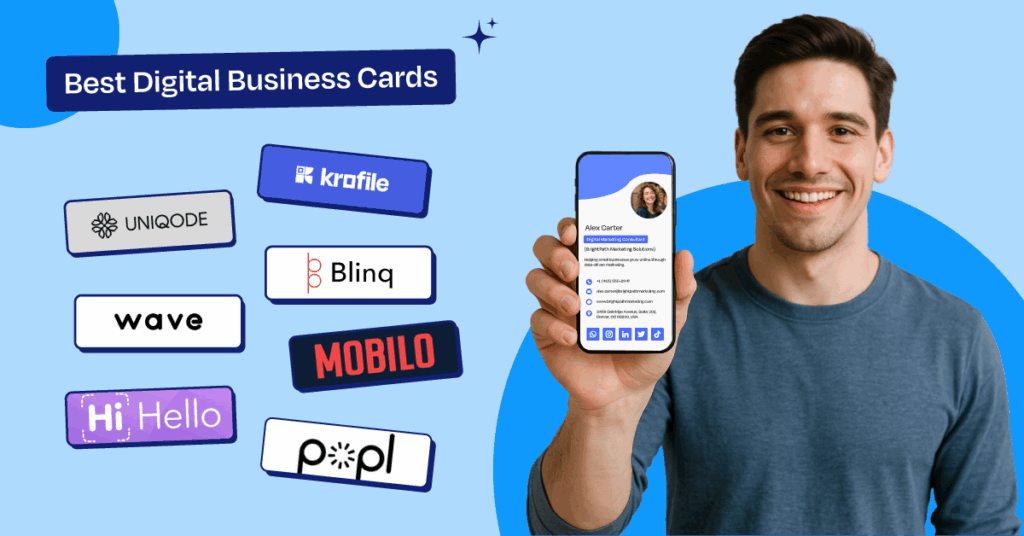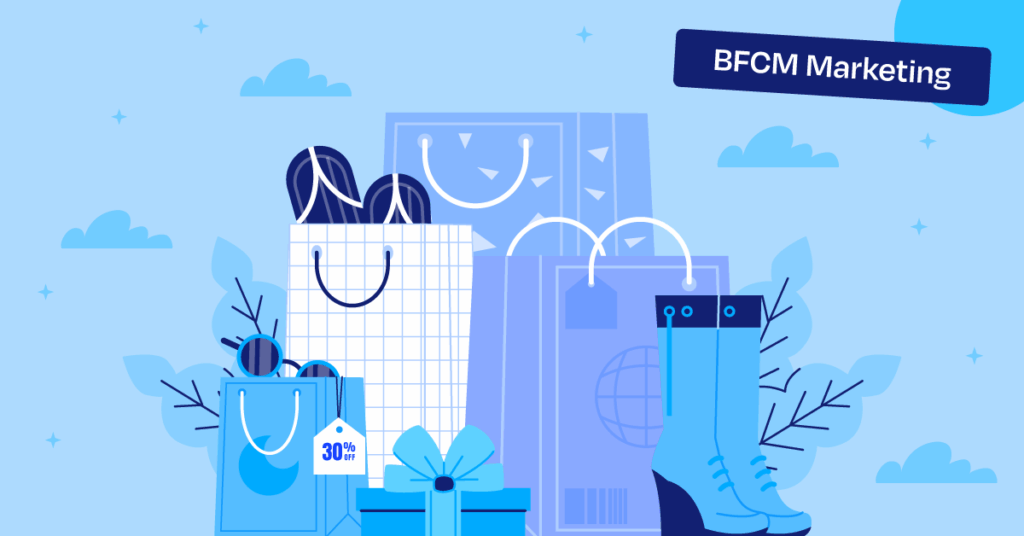In 2025, local businesses aren’t just competing on price or quality—they’re competing on trust. And trust starts with online reviews. According to Bright Local’s 2024 survey, 99% of consumers read reviews before choosing a local business. That’s why the question I hear most often from clients is: “Should I focus on Yelp or Google reviews?”
The short answer? Google reviews are essential—but depending on your industry, Yelp might be just as critical. In this guide, I’ll break down Yelp vs Google reviews, what’s working now, and how to build a compliant review strategy that actually moves the needle.
Whether you’re running a salon, dental office, restaurant, or HVAC company, this post will help you get more reviews, boost visibility, and avoid common pitfalls.
Curious how much reviews impact local SEO? Check our Local SEO stats post to learn more.
Why Online Reviews Can Make or Break Your Local Business
Let me be real with you—your online reviews aren’t just a bonus anymore. In 2025, they’re the deciding factor for whether someone chooses you or your competitor.
Here’s why:
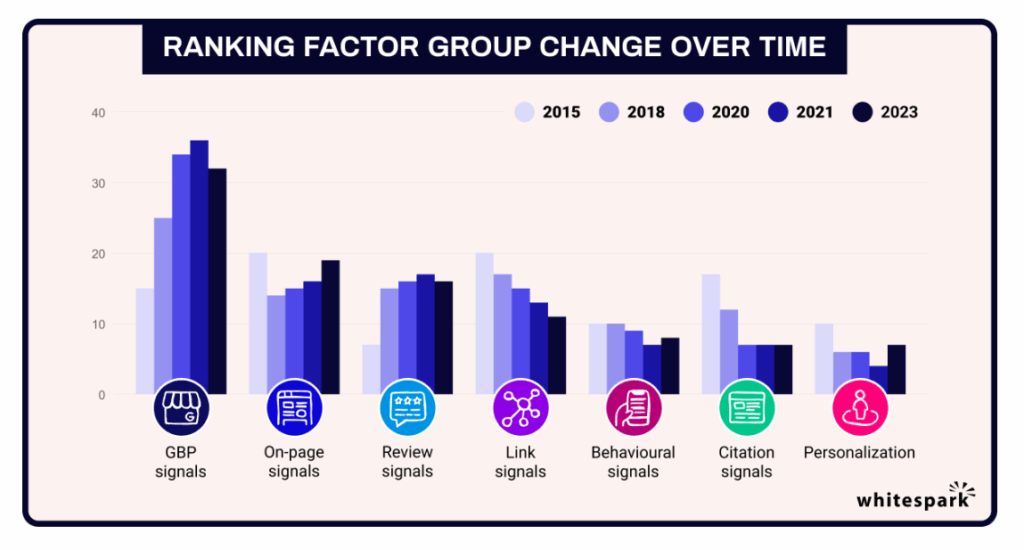
1. Reviews Directly Influence Your Local SEO Ranking
If you want to show up in the Google 3-Pack or on Maps when someone searches for “best dentist near me” or “top HVAC service in [your city],” reviews play a key role.
According to Whitespark’s 2023 Local Ranking Factors Report, review signals now contribute 17% to local pack rankings, and this number is expected to increase in 2025.
The key signals include:
- Review quantity
- Review velocity (how often you get them)
- Review content (keywords mentioned)
- Star ratings
2. Reviews Influence Customer Action
Reviews don’t just help you rank—they help you convert.
A BrightLocal survey found that 69% of consumers feel positive about using a business if it has reviews describing positive experiences, and only 3% would consider using a business with an average rating below 3 stars.
Here’s what that means:
Even if you’re the best in town, you’ll get skipped if your reviews don’t show it.
3. They Shape First Impressions—and Foot Traffic
For local businesses, online reviews are your digital storefront. A person searching for you will see your Google Business Profile or Yelp page before they see your website. And the results are measurable:
A Harvard Business School study found that a one-star increase on Yelp can lead to a 5–9% revenue boost for restaurants.
That stat might be Yelp-specific, but the impact is the same on Google—if not greater, given how much real estate Google controls in search results.
So if you’ve been treating reviews like a passive thing that “just happens”—2025 is your sign to make them part of your strategy.
Why Google Reviews Are Essential for Local SEO

Let’s be clear: if your business isn’t showing up on Google, you’re invisible to most potential customers. And in 2025, Google reviews aren’t just a trust signal—they’re a ranking factor.
Here’s why every local business should prioritize Google reviews first:
1. Google Reviews Fuel Your Visibility on Maps and Local Search
Google controls over 89.57% of the mobile search engine market share in the US (StatCounter, 2025). That means when people search for “hair salon near me” or “best HVAC repair,” Google Maps and the Local 3-Pack appear first—and who shows up is heavily influenced by reviews.
Google’s documentation confirms that review quantity and quality help determine local ranking (Google Support). It’s not just about keywords on your website anymore—your customers’ voices are part of your SEO.
2. Google Reviews Build Authority with Real Keywords
One underrated feature? When customers describe their experience using keywords (“affordable AC repair in Phoenix”), Google actually uses those words to understand what your business is known for.
This user-generated content acts like micro-reviews for search intent. If you run a niche service—like “emergency root canal in Brooklyn”—this can help you show up for high-intent searches without paying for ads.
3. Review Collection is Easy—and Policy-Friendly
Unlike Yelp, Google welcomes review requests (as long as they’re not incentivized). That’s huge for local businesses looking to scale reviews without violating terms of service.
The most effective strategies I’ve helped businesses implement include:
- Embedding review links in email footers
- Printing QR codes on receipts or front desk signage
- Using SMS follow-ups post-service
And with a platform like Krofile, you can automate these steps—generating ready-to-share links, QR posters, and even branded thank-you messages that help drive more 5-star reviews.

4. Google Reviews Drive Real Customer Actions
The more recent and relevant your Google reviews, the more likely a potential customer is to take action—whether that’s clicking “Call,” requesting directions, or booking online.
According to a 2025 survey by BrightLocal, 76% of consumers say they “regularly” read online reviews when browsing for local businesses, and 87% of consumers used Google to evaluate a local business in the last year.
Here’s what that means:
If your Google Business Profile is packed with timely, helpful reviews—and you actively respond—you’re not just building trust. You’re increasing conversions before people even visit your website.
Bonus tip: Reviews with a response from the business owner increase customer trust by up to 17%, according to the same survey.
Why Yelp Still Matters for Restaurants, Salons, and Local Services

Now, while Google is the must-have foundation, Yelp still plays a critical role—especially for experience-based businesses like restaurants, salons, spas, and wellness services.
Here’s why I advise certain clients not to ignore Yelp:
1. Yelp Dominates Lifestyle-Intent Search Queries
Yelp consistently ranks on the first page of Google for high-intent searches like:
- “best sushi near me”
- “top-rated hair salons in [city]”
- “massage therapy reviews”
That means even when someone starts their search on Google, they often end up clicking into a Yelp result. According to SimilarWeb data, Yelp gets over 145 million monthly visits, with a large portion landing on category and location-specific review pages.
2. Yelp Users Dig Deep and Spend More
Yelp customers behave differently than Google users. They don’t just look at star ratings—they scroll through photos, read detailed experiences, and often compare 2–3 options.
This isn’t just anecdotal. A Nielsen study commissioned by Yelp found that Yelp users are 97% more likely to make a purchase after visiting Yelp compared to other platforms. And more importantly—they spend more per visit, especially in categories like dining, beauty, and home services.
3. Visual Storytelling = Trust
Photos, captions, and detailed reviews build authenticity. Yelp allows customers to upload their own images—creating a photo-first review experience that many lifestyle consumers trust more than just a rating.
If you’re in food, beauty, or personal care—Yelp’s user-generated photos can be more persuasive than even your Instagram.
4. Yelp Still Owns its Niche
Here’s my advice: If your business is built on experience, ambiance, or aesthetics—Yelp should absolutely be part of your review strategy, right alongside Google.
But that doesn’t mean Yelp is perfect. In the next section, I’ll break down its most frustrating flaw.
The Harsh Truth About Yelp’s Review Filter (And How It Hurts)

Now let’s talk about the elephant in the room—Yelp’s infamous review filter.
If you’ve ever checked your Yelp page and noticed that glowing 5-star reviews aren’t showing up publicly, you’re not imagining things. Yelp’s algorithm often hides reviews in a section called “Not Recommended.” And no matter how genuine the review is, it may never see the light of day.
1. Yelp Filters Out a Significant Portion of Real Reviews
On average, Yelp filters out 25% to 40% of submitted reviews, especially those from newer accounts or users with minimal review history.
Many legitimate reviews from happy customers get flagged simply because the reviewer:
- Doesn’t have a Yelp profile photo
- Hasn’t written enough past reviews
- Posted the review from a different location than usual
It’s frustrating—especially when you’ve done everything right as a business owner.
2. It Damages Trust with Both Owners and Customers
I’ve worked with restaurant owners who had 50+ genuine reviews hidden—and they couldn’t do anything about it. Yelp’s stance? They don’t remove or reinstate filtered reviews by request.
This lack of transparency has been a consistent pain point discussed on Reddit and industry forums. You’ll find entire threads titled things like:
- “Why are my Yelp reviews disappearing?”
- “Is Yelp’s filter killing my small business?”
Reddit threads like r/smallbusiness are filled with complaints. Many describe the same experience: getting authentic reviews from happy customers, only to watch Yelp’s algorithm hide them for no clear reason.
And honestly, it’s hard to defend Yelp on this one.
3. The Impact is Real—Especially for New Businesses
If you’re just starting out, Yelp’s filter can severely under-represent your actual customer satisfaction. That means you might show up with a 3.0-star average based on two reviews, while ten solid 5-star reviews sit buried in the “not recommended” section.
In competitive categories like food, beauty, and wellness—this hurts visibility and trust, plain and simple.
Yelp Ads: Should You Pay to Play in 2025?
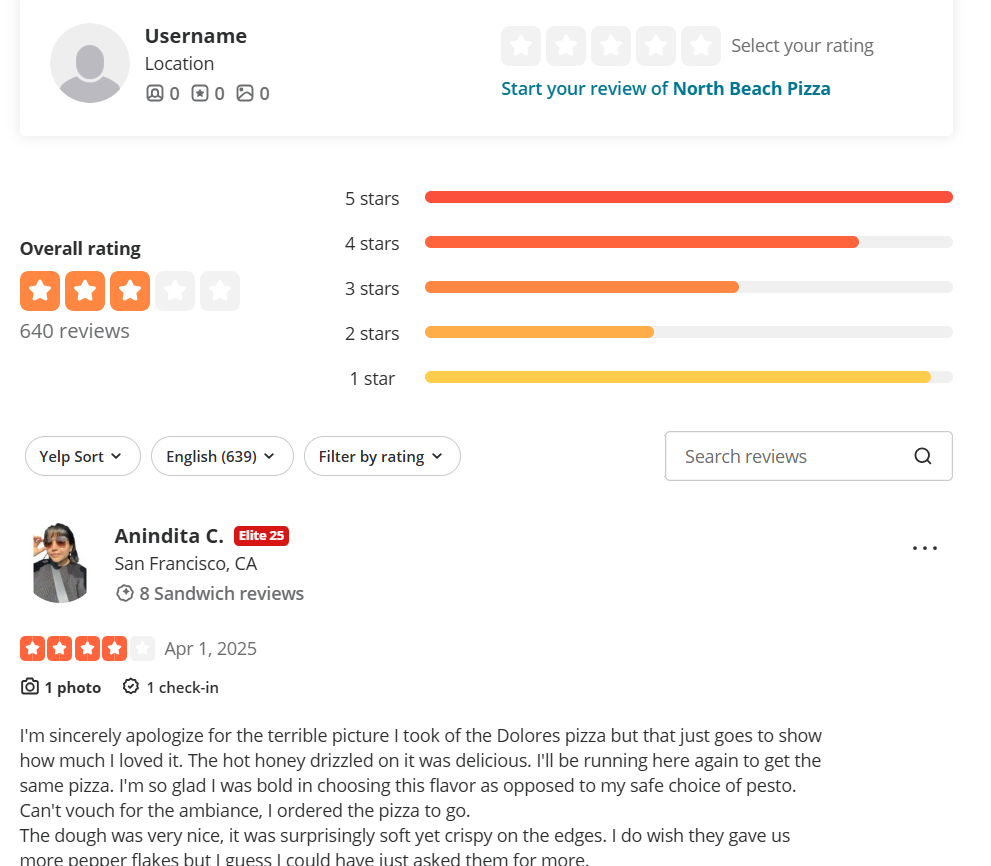
Let’s be honest—if you’ve ever claimed your Yelp profile, you’ve likely received a few (or many) calls from Yelp’s sales team encouraging you to try their paid advertising.
But is it worth it in 2025?
From what I’ve seen helping clients across food, beauty, and home services—it’s not a one-size-fits-all answer. Yelp Ads can work, but only if you approach them with clear expectations.
1. Yelp Ads Offer Visibility—But Come with Strings
Yelp Ads give your business premium placement in local search results and competitor listings. Your listing appears at the top with a small “Ad” label, and you can showcase a call-to-action, photo, or promo.
However, these ads often come with minimum monthly budgets and long-term contracts—and many business owners aren’t thrilled with the ROI.
In fact, according to a 2023 analysis by ReviewTrackers, the most common complaint among Yelp advertisers is paying for low-quality clicks or irrelevant leads.
2. Results Vary by Industry
Here’s what I tell clients:
- Restaurants, salons, and spas tend to see better results—Yelp users in these categories are actively comparing multiple businesses before booking.
- B2B, trades, and niche services? Less so. Yelp’s algorithm often shows ads to users outside your ideal customer profile.
I’ve worked with a plumbing business that burned $800/month on Yelp ads with no measurable conversions—while a local day spa saw a 3x ROI using the same budget.
3. There are Limited Controls
Unlike Google Ads, Yelp doesn’t give you much control over keyword targeting or bidding. You can exclude certain competitor names, but not much else.
So if someone is searching for a totally unrelated service and happens to see your ad—you may still pay for that click.
4. Consider Hybrid Visibility Instead
If Yelp works well for your industry, combine free profile optimization with selective paid visibility:
- Keep your photos, business info, and services updated
- Use review badges or QR codes to drive real customer reviews
- Consider Krofile’s review showcase widget to highlight Yelp + Google reviews on your site—so you’re not solely dependent on Yelp to convert leads
Bottom line? Test with caution. Don’t get locked into a long-term Yelp contract without running a short trial and tracking the quality of your leads closely.
Google vs Yelp: Which One Is More Worth Your Time?

By now, you’ve seen the strengths and weaknesses of both platforms. But let’s get practical: where should you actually focus your energy in 2025?
Here’s how I break it down when consulting local businesses:
| Factor | Yelp | |
| Primary Strength | High visibility, SEO impact, and review volume | Deep engagement in experience-focused industries |
| Best For | HVAC, dental clinics, auto repair, pet care | Restaurants, salons, wellness centers, boutique retail |
| User Intent | Search-first (location, hours, quick decisions) | Experience-first (ambience, visuals, comparisons) |
| Platform Control | Full control of profile, reviews, posts, and updates | Limited control, aggressive filtering |
| Review Publishing | Most verified reviews go live unless flagged | Many legitimate reviews get filtered |
| Visual Appeal | Basic photo support, more text-based | Photo-heavy, visual-forward design |
| Review Strategy Flexibility | Can request reviews and respond freely without penalties | Strict policies; soliciting reviews can lead to filtered or removed posts |
| Integration & Conversion | Review widgets can be embedded on your site | Yelp reviews stay mainly within Yelp |
| Local SEO Impact | High—reviews impact map rankings, profile views, and traffic | Low—Yelp reviews rarely influence Google search visibility |
Based on this comparison, Google is the clear winner for most local businesses—especially if your goal is to boost visibility, SEO rankings, and review volume. Its integration with Google Maps and Search means your reviews show up right when potential customers are looking for your service.
On the other hand, Yelp can still be valuable if you’re in a visual-first or experience-based industry like dining or beauty, where users actively browse and compare. The smartest strategy in 2025? Start with Google as your foundation, then layer in Yelp if your audience is active there. This dual approach gives you broader reach without spreading yourself too thin.
Collecting Reviews the Smart Way (Without Breaking Policies)

One of the most common mistakes I see local businesses make is asking for reviews the wrong way—either violating platform rules or coming off as inauthentic. In 2025, platforms are more sensitive than ever, so getting this right is crucial.
1. Know the Rules—or Risk Penalties
Each platform has its own policy:
- Google allows you to ask for reviews, but does not permit incentives like discounts or freebies in exchange for a review (Google Policy).
- Yelp strongly discourages direct asks, especially bulk requests. They prefer reviews happen “organically” and may filter ones that look solicited.
Violating these can result in filtered reviews—or worse, account penalties or public flags.
2. Use Compliant Language in Your Requests
Instead of “Please leave us a 5-star review,” say something like:
“If you enjoyed your visit, we’d really appreciate your feedback on Google/Yelp—it helps others discover us!”
This avoids leading language while still encouraging action.
Here are a few sample scripts I’ve seen work well:
- In email receipts:
“Thanks for choosing us! Have 60 seconds? We’d love to hear how we did.”
- At checkout:
“If you’d like to leave a review, just scan this code—no app needed.”
- In follow-up texts:
“Hi [First Name], thanks again for your visit today! If everything went well, we’d be grateful if you left a quick review here: [link]”
3. Use QR Codes and Touchpoints, Not Pressure
Strategic placement matters. Here’s where reviews feel natural—not pushy:
- At reception desks or waiting areas
- On printed invoices or thank-you cards
- In follow-up messages sent 1–2 days after the experience
- In email footers or appointment reminders
It’s about making the review process easy—not forcing it.
4. Track and Respond to Reviews
Once reviews start coming in, respond to every one—even the negative ones. Thoughtful replies show that you care, which encourages others to leave honest feedback too.
And if you notice certain request formats aren’t getting reviews? Adjust and test. Review collection is not set-it-and-forget-it—it’s something to refine over time.
What is the Best Way to Showcase Reviews Across Platforms
Collecting great reviews is step one—but where you display them can make or break their impact. In 2025, consumers expect to see social proof wherever they interact with your brand—not just buried on third-party platforms.
Here’s how real businesses are showcasing their reviews the smart way:
1. Don’t Send Users on a Platform Scavenger Hunt
You’ve probably seen businesses say:
“Check our reviews on Google, Yelp, Facebook, Trustpilot…”
The problem? That splits your credibility across multiple places and makes people work to find what they’re looking for.
Instead, consolidate your best reviews into one centralized place—like your homepage, service pages, or landing pages. This keeps users focused on your business, not bouncing between platforms.
2. Prioritize Recency and Authenticity
A 5-star review from two years ago doesn’t build trust like a 4-star review from last week.
When choosing which reviews to display:
- Lead with the most recent and detailed ones
- Show names, dates, and sources (Google, Yelp, etc.)
- Avoid cherry-picking only perfect ratings—authenticity matters more than polish
3. Use Visuals and Design to Your Advantage
Text-heavy testimonials can be skipped. Instead, format reviews with:
- Clear star ratings
- Customer first names or initials
- Logos or platform icons for context
- Pull quotes for easy scanning
Even better, rotate them on your homepage or near call-to-action buttons (like “Book Now” or “Get a Quote”) to reinforce trust right before a customer makes a decision.
4. Embed Live Feeds When Possible
If you’re comfortable with transparency, embedded live feeds from Google or Yelp can be powerful—especially for industries where constant feedback matters (like hospitality, beauty, or service).
This shows prospects that:
- You’re active and relevant
- People are still talking about you
- You have nothing to hide
Final Verdict: Master Google First, Then Add Yelp Strategically
Let’s wrap it up with the big picture.
If you’re a local business owner trying to decide where to focus your review strategy in 2025, here’s the simplest advice I give:
1. Google is Your Foundation
It’s where most people search. It’s where they see your location, hours, phone number, and photos—before they even visit your website.
If you don’t have a strong Google Business Profile with fresh, relevant reviews, you’re already behind. This platform offers:
- Greater control over your listing
- Easier review collection
- Reviews that directly boost search visibility
So if you’re just starting out or have limited bandwidth—go all in on Google first.
2. Yelp is a Smart Addition For the Right Industries
If your business depends on customer experience—think restaurants, salons, spas, or boutique services—then Yelp can’t be ignored. It’s where review-conscious consumers dig deeper, compare visuals, and read longer feedback.
But go in with a strategy:
- Optimize your free profile
- Don’t rely on ads without testing
- Understand how their review filter works (and avoid pushing for reviews too aggressively)
3. Balance is What Builds Trust
The most successful businesses I’ve worked with don’t choose between platforms—they connect them. They:
- Start with consistent Google reviews
- Add Yelp where it aligns with their industry
- Showcase both strategically on their site or social channels
- Avoid spreading themselves thin chasing every platform
It’s not about being everywhere—it’s about being credible and consistent where it matters most.
Use a Tool Like Krofile to Simplify Your Entire Review Strategy
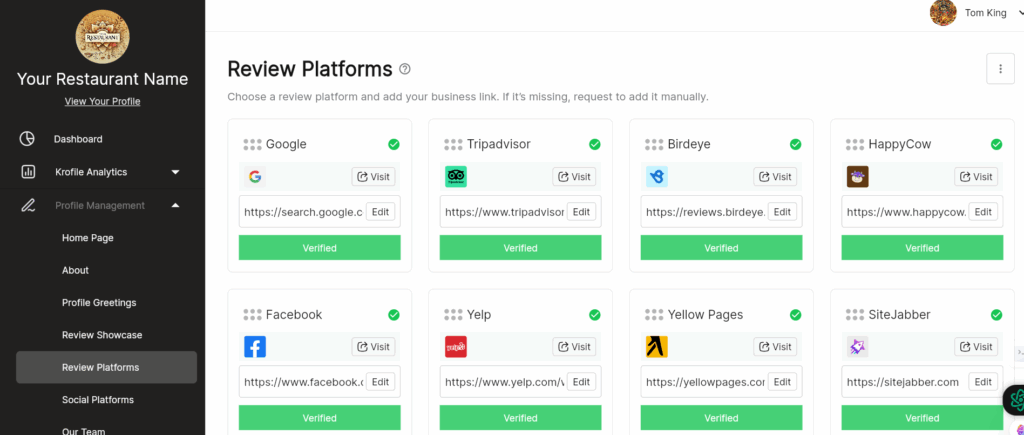
If managing Google, Yelp, and other review platforms feels overwhelming—you’re not alone. Most small businesses don’t have time to juggle multiple dashboards, links, and follow-up processes.
That’s where a review collection tool can save you serious time and effort.
A platform like Krofile:
- Centralizes your review links across Google, Yelp, and more
- Lets you send automated follow-up messages that stay within platform rules
- Offers easy-to-embed review widgets for your website, so you can build trust without redirecting visitors

Whether you’re just starting out or already getting reviews regularly, the goal is simple: make your reviews work together, not compete.




